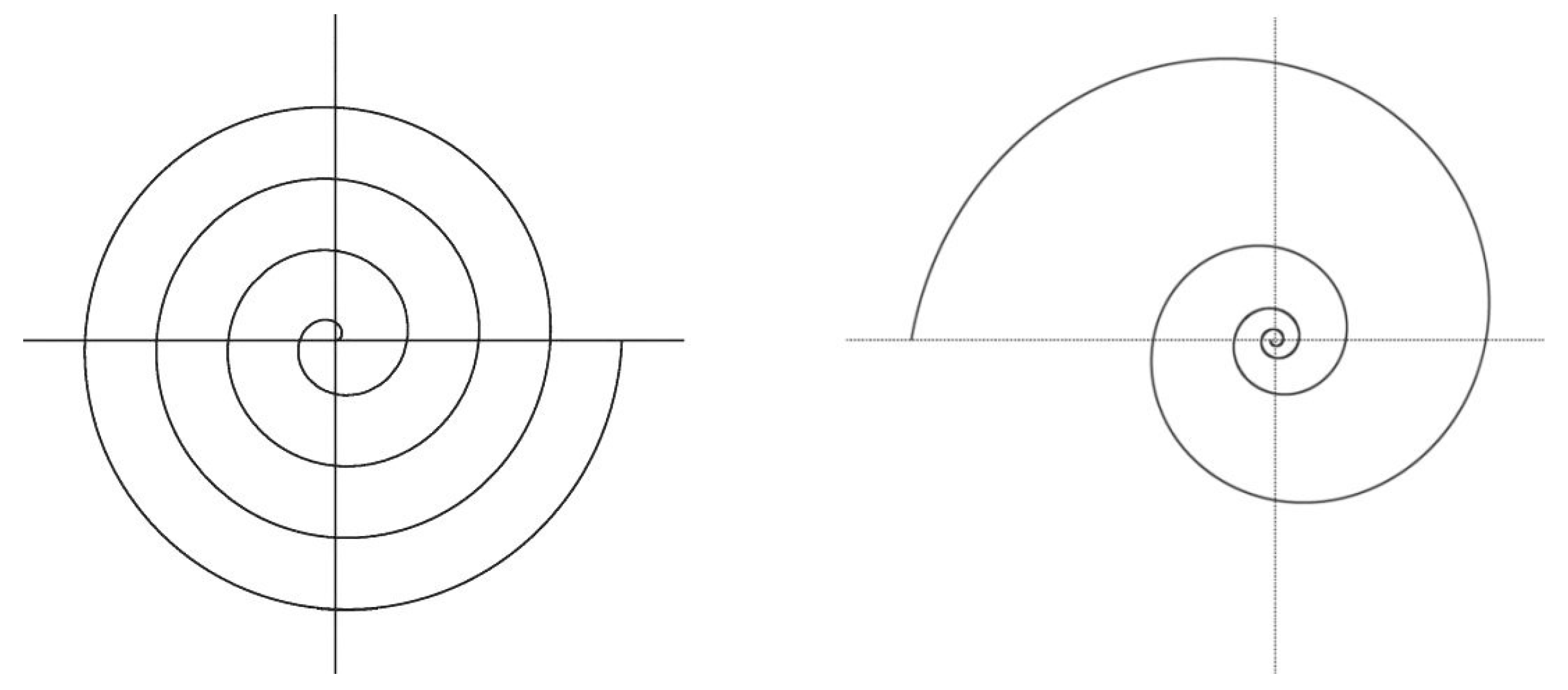Complex Spirals and Pseudo-Chebyshev Polynomials of Fractional Degree
Abstract
:1. Introduction
2. Spirals
- The angle between the tangent at a point and the polar radius passing through that point is constant.
- The angle of inclination with respect to the concentric circles with the center in the origin is also constant.
3. The Complex Bernoulli Spiral
3.1. Rhodonea Curves
3.2. Chebyshev Polynomials
4. Pseudo-Chebyshev Polynomials
4.1. The Case of Half-Integer Degree
4.2. Recurrence Relations
4.3. More General Formulas
Particular Results
4.4. Orthogonality for Half-Integer Degree
5. Conclusions
Funding
Acknowledgments
Conflicts of Interest
References
- Bini, D.; Cherubini, C.; Filippi, S.; Gizzi, A.; Ricci, P.E. On the universality of spiral waves. Commun. Comput. Phys. 2010, 8, 610–622. [Google Scholar]
- Gielis, J. The Geometrical Beauty of Plants; Atlantis Press: Paris, France, 2017. [Google Scholar]
- Heath, T.L. The Works of Archimedes; Google Books; Cambridge University Press: Cambridge, UK, 1897. [Google Scholar]
- Archibald, R.C. Notes on the logarithmic spiral, golden section and the Fibonacci series. In Dynamic Symmetry; Hambidge, J., Ed.; Yale University Press: New Haven, CT, USA, 1920; pp. 16–18. [Google Scholar]
- Tenca, L. Guido Grandi Matematico Cremonense; Istituto lombardo di Scienze e Lettere: Milano, Italy, 1950. [Google Scholar]
- Rivlin, T.J. The Chebyshev Polynomials; Wiley: New York, NY, USA, 1990. [Google Scholar]
- Ricci, P.E. Alcune osservazioni sulle potenze delle matrici del secondo ordine e sui polinomi di Tchebycheff di seconda specie. Atti della Accademia delle Scienze di Torino 1975, 109, 405–410. [Google Scholar]
- Ricci, P.E. Sulle potenze di una matrice. Rend. Mat. 1976, 9, 179–194. [Google Scholar]
- Ricci, P.E. I polinomi di Tchebycheff in più variabili. Rend. Mat. 1978, 11, 295–327. [Google Scholar]
- Mason, J.C.; Handscomb, D.C. Chebyshev Polynomials; Chapman and Hall: New York, NY, USA; CRC: Boca Raton, FL, USA, 2003. [Google Scholar]
- Boyd, J.P. Chebyshev and Fourier Spectral Methods, 2nd ed.; Dover: Mineola, NY, USA, 2001. [Google Scholar]
- Srivastava, H.M.; Ricci, P.E.; Natalini, P. A Family of Complex Appell Polynomial Sets. Real Acad. Sci. Exact. Fis Nat. Ser. A Math. 2018. submitted. [Google Scholar]
- Srivastava, H.M.; Manocha, H.L. A Treatise on Generating Functions; Halsted Press (Ellis Horwood Limited, Chichester), John Wiley and Sons: New York, NY, USA; Chichester, UK; Brisbane, Australia; Toronto, ON, Canada, 1984. [Google Scholar]
- Kim, T.; Kim, D.S.; Dolgy, D.V.; Park, J.-W. Sums of finite products of Chebyshev polynomials of the second kind and of Fibonacci polynomials. J. Inequal. Appl. 2018. [Google Scholar] [CrossRef] [PubMed]
- Kim, T.; Kim, D.S.; Kwon, J.; Dolgy, D.V. Expressing Sums of Finite Products of Chebyshev Polynomials of the Second Kind and of Fibonacci Polynomials by Several Orthogonal Polynomials. Mathematics 2018, 6, 210. [Google Scholar] [CrossRef]
- Kim, D.S.; Dolgy, D.V.; Kim, T.; Rim, S.-H. Identities involving Bernoulli and Euler polynomials arising from Chebyshev polynomials. Proc. Jangjeon Math. Soc. 2012, 15, 361–370. [Google Scholar]
- Hall, L. Trochoids, Roses, and Thorns-Beyond the Spirograph. Coll. Math. J. 1992, 23, 20–35. [Google Scholar]
- Aghigh, K.; Masjed-Jamei, M.; Dehghan, M. A survey on third and fourth kind of Chebyshev polynomials and their applications. Appl. Math. Comput. 2008, 199, 2–12. [Google Scholar] [CrossRef]
- Doha, E.H.; Abd-Elhameed, W.M.; Alsuyuti, M.M. On using third and fourth kinds Chebyshev polynomials for solving the integrated forms of high odd-order linear boundary value problems. J. Egypt. Math. Soc. 2014, 23, 397–405. [Google Scholar] [CrossRef]
- Kim, T.; Kim, D.S.; Dolgy, D.V.; Kwon, J. Sums of finite products of Chebyshev polynomials of the third and fourth kinds. Adv. Differ. Equ. 2018, 2018, 283. [Google Scholar] [CrossRef]
- Sloane, N.J.A.; Plouffe, S. The Encyclopedia of Integer Sequences; Academic Press: San Diego, CA, USA, 1995. [Google Scholar]









© 2018 by the author. Licensee MDPI, Basel, Switzerland. This article is an open access article distributed under the terms and conditions of the Creative Commons Attribution (CC BY) license (http://creativecommons.org/licenses/by/4.0/).
Share and Cite
Ricci, P.E. Complex Spirals and Pseudo-Chebyshev Polynomials of Fractional Degree. Symmetry 2018, 10, 671. https://doi.org/10.3390/sym10120671
Ricci PE. Complex Spirals and Pseudo-Chebyshev Polynomials of Fractional Degree. Symmetry. 2018; 10(12):671. https://doi.org/10.3390/sym10120671
Chicago/Turabian StyleRicci, Paolo Emilio. 2018. "Complex Spirals and Pseudo-Chebyshev Polynomials of Fractional Degree" Symmetry 10, no. 12: 671. https://doi.org/10.3390/sym10120671
APA StyleRicci, P. E. (2018). Complex Spirals and Pseudo-Chebyshev Polynomials of Fractional Degree. Symmetry, 10(12), 671. https://doi.org/10.3390/sym10120671



